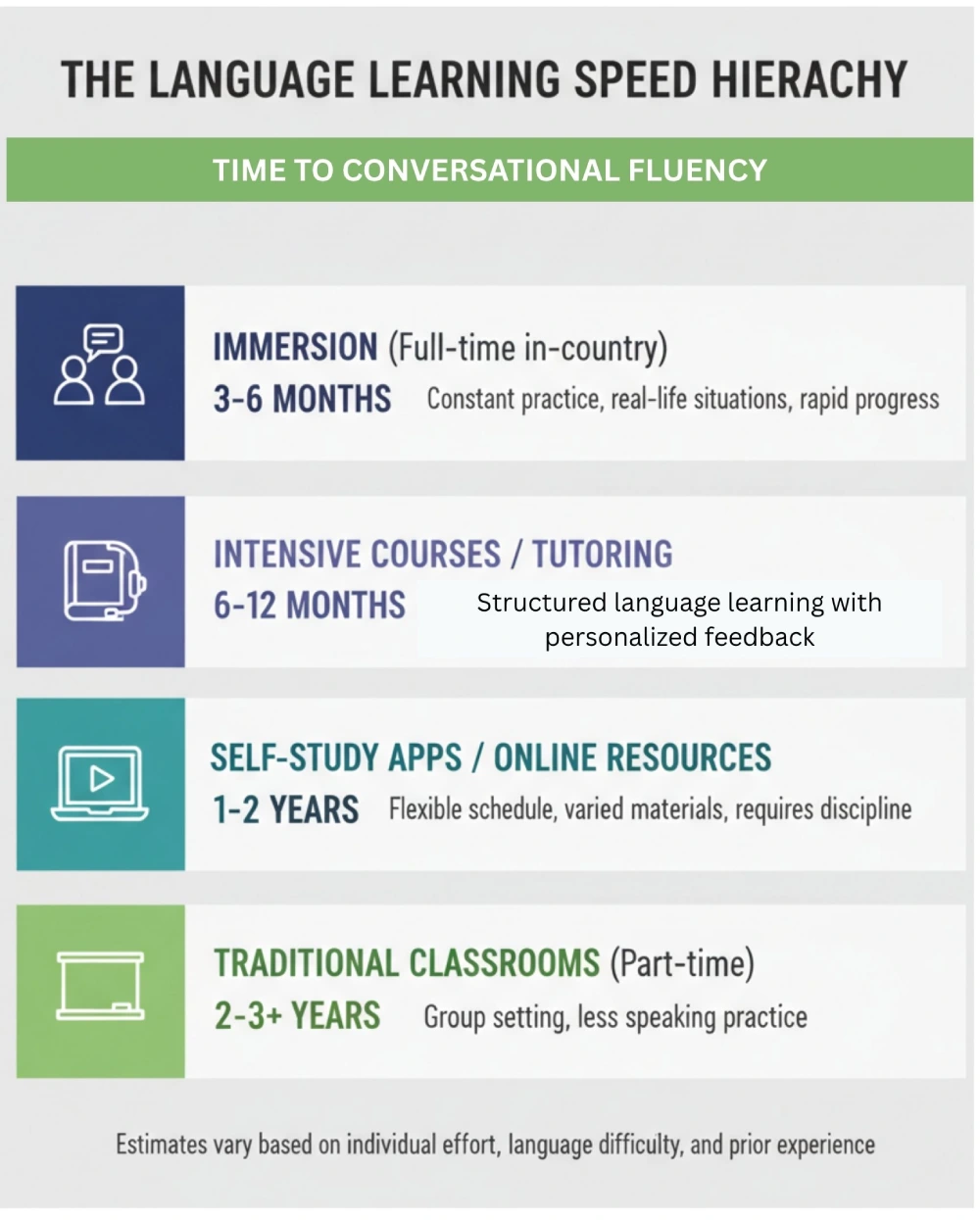Learn How to Start an E-commerce Business Online
We’ll walk you through everything you need to know as a beginner about e-commerce and get your foot through the door.
Create learner account
Anahit Babkenyan
Nov 04, 2025My friend Emma downloaded Duolingo three months before her trip to Mexico. By the time she landed in Guadalajara, she could confidently say "the apple is red," but couldn’t figure out how to ask the grocery store clerk where to find bottled water.
Then there’s Marcus. He spent two months having weekly conversations with a Spanish tutor. His grammar was rough and his accent made native speakers pause, but he could actually communicate—order food, ask for directions, and joke with the hotel staff.
The difference in their language abilities was striking, despite similar hours of study.
Everyone wants the magic solution. The app that teaches you French while you sleep. The "one weird trick" that polyglots supposedly use.
Here’s what research on language acquisition actually shows: conversation with real people remains the fastest method. Not the most exciting answer, but the most effective one.
Your brain evolved to learn language through social interaction. When you’re having a real conversation, your neurons process information differently than when you’re tapping through app exercises. You remember new words attached to emotions and situations. That embarrassing moment when you mixed up two similar-sounding words? You’ll never forget the correct one now.
Language apps simply cannot replicate that experience.
The other element that makes tutoring effective: accountability. When there’s an actual person expecting you for your Tuesday afternoon session, you show up. You prepare. You practice. Meanwhile, you’ve been ignoring app notifications for three weeks.
A language teacher or private tutor also adapts in ways software never will. They catch your specific pronunciation issues. They rephrase concepts when you look confused. They teach you the expressions people actually use in daily life instead of formal textbook phrases that make you sound dated.
This is why working with a language tutor accelerates progress more than any other single learning approach.

Quick question: How many words do you need to hold a basic conversation in a new language?
If you guessed thousands, you’re overestimating. The answer is closer to 300-500 basic words.
Research shows the 100 most common words in any language make up roughly half of everything people say in normal conversation. Learn 1,000 words and you’re understanding about 80% of typical dialogue.
This insight changes your entire learning plan.
Stop memorizing random vocabulary from textbooks. From personal experience, I wasted weeks learning Russian words like "typewriter" and "telegraph" because they appeared in my beginner course. Those never came up in actual conversation.
Meanwhile, I struggled with practical phrases like "I don’t understand" or "please speak slower."
Focus on high-frequency vocabulary first. The verbs everyone uses constantly: want, go, have, need, and like. Question words: what, where, when, why, how. Essential adjectives: good, bad, big, small, expensive.
Master these before moving on. Everything else can wait until you’re having real conversations and discovering what new vocabulary you actually need.
Many language learning methods recommend using a repetition system for these core words. Spaced repetition helps transfer new words from short-term to long-term memory more efficiently than cramming.
Find a tutor for this topic
This is where most people derail their language learning journey.
They study for months, thinking they’ll start speaking once they’ve learned more grammar or have a larger vocabulary list.
That day never arrives. There are always more grammar rules to learn. Always more words you don’t know.
Meanwhile, your speaking ability stays frozen at zero.
The reality: you learn to speak by speaking imperfectly. There’s no shortcut. You will conjugate verbs incorrectly. You will use the wrong articles. You’ll blank on simple words mid-sentence and resort to gestures.
It’s uncomfortable, but necessary.
Every fluent speaker goes through this phase. The difference between people who eventually become fluent and those who stay perpetual beginners? The fluent ones were willing to sound awkward for a while.
I started speaking Portuguese after about ten days of study. I could barely form complete sentences. But those early, messy conversations taught me more than a month of solo study could.
Your mistakes reveal exactly what to learn next. Can’t remember how to say "yesterday"? Now you know what to study tonight.
The best way to start is by finding a conversation partner or booking sessions with someone who has teaching experience. They create a safe environment for making those essential early mistakes.
Most people treat pronunciation as something to address later. This is a mistake.
After six months of saying things incorrectly, your mouth develops muscle memory for those wrong sounds. Correcting it later requires significantly more effort than learning properly from the start.
Tackle pronunciation during your first week or two. Watch native speakers on video. Notice where their tongue goes for different sounds. Pay attention to sounds that don’t exist in your native language—those are the ones you’re likely getting wrong.
English speakers learning Spanish often struggle with rolled Rs. Those learning Mandarin must master tonal distinctions. Russian learners often face challenges with consonant clusters and case endings.
Dedicate time to your specific problem sounds early. Audio recordings can help—record yourself and compare to native pronunciation. It feels awkward, but it produces results.
Good pronunciation also builds speaking confidence. When you know you sound reasonably clear, you’re more willing to practice. That confidence leads to more conversation practice, which accelerates improvement.
Everyone mentions "immersion," but few people implement it properly. They study for an hour, then spend the remaining day entirely in their own language.
That’s not immersion—that’s minimal language use.
Real immersion means structuring your environment so you constantly encounter your target language. Switch your phone settings. Follow social media accounts that post in French or Japanese. Listen to podcasts while doing chores. Watch YouTube videos and TV shows about topics you genuinely enjoy—just in your target language.
You won’t understand everything initially. The goal is training your brain to process that language as part of normal life rather than a special study activity.
When I was learning Portuguese, I started watching Brazilian content even though I only understood about half. I followed Brazilian creators. Changed my Netflix region for their programming.
Did I understand every word? No. But after a few months, Portuguese felt familiar rather than foreign. When I visited São Paulo, my brain was already accustomed to the language.
The key is selecting content you’d actually enjoy. Don’t force yourself through news broadcasts if you find news boring in your mother tongue. Choose content matching your interests—you’ll maintain consistency instead of quitting after a few days.
This approach provides comprehensible input, a concept from linguistics research showing we learn best from content slightly above our current level.

This technique sounds unusual, but it proves highly effective for the learning process.
Start narrating your day mentally in your target language, even simple things.
Making breakfast? "I need eggs. The coffee is hot."
Walking to work? "That dog is large. The weather is cold."
This provides free practice anywhere. Waiting in line? Think about your evening plans in French. Stuck in traffic? Describe your surroundings in Spanish.
You’ll immediately discover which everyday words you’re missing. Try describing your morning routine and notice how often you think "what’s the word for...?" Now you know exactly what to look up. Dictionary apps can help bridge these gaps quickly.
When you have real conversations, you’re already mentally warmed up. Your brain’s already operating in that language instead of making a jarring switch.
Start with the simple present tense. After a few weeks, you’ll naturally express more complex thoughts. Eventually, you’ll think in your target language automatically—that’s when real progress becomes obvious.
The best method for fast progress involves stacking different strategies rather than relying solely on one learning approach.
Your foundation should be regular speaking practice with native speakers. This could mean tutoring sessions, language exchanges, or conversation groups. Aim for three to four hours weekly minimum.
Layer other activities around that core: podcasts during commutes, reading for 20 minutes daily, vocabulary review using a repetition system, and thinking in your target language during routine tasks.
This multi-angle approach means encountering the same content in varied contexts. You hear a phrase in a podcast. See it in an article the next day. Use it in conversation that week. This varied repetition strengthens retention far better than drilling one thing repeatedly.
Language learning websites offer additional resources, though they work best as supplements to conversation practice rather than replacements.
If possible, create intensive study periods. Four hours daily for two weeks typically produces better results than one hour daily for two months. Your brain needs concentrated language input to begin processing naturally.
Working with a tutor helps coordinate these various language learning methods into a coherent study plan tailored to your language-learning goals.
Several widespread errors significantly slow the learning process.
First, excessive focus on grammar explanations before practical language use. People spend months memorizing verb conjugation tables but struggle to form basic sentences. Grammar understanding develops through usage, not purely through studying charts.
Language classes at a traditional language school often emphasize grammar drills over actual communication, which can slow practical fluency development.
Second, inconsistency. Studying three hours one day per week doesn’t work as well as 30 minutes every single day. Your brain needs regular exposure to consolidate learning between sessions.
Third, relying exclusively on apps. They’re useful for vocabulary building and grammar introduction, but cannot replace human interaction. You need real people to correct pronunciation, answer specific questions, and provide genuine conversation practice—something Google Translate and automated systems cannot do.
Fourth, attempting to learn different languages simultaneously. This splits attention and slows progress in both. Focus on one second language until reaching conversational ability before adding another.
Fifth, using word lists and pocket dictionaries as primary study tools rather than engaging with actual language in context. While these tools help, they work best supporting active conversation practice.

Learning a language quickly isn’t about discovering some hidden technique others missed.
It’s about using proven language learning methods consistently, even when progress feels slow.
Prioritize conversation with language speakers who can provide feedback. Surround yourself with the language daily through listening and reading. Speak from day one despite the awkwardness. Focus first on common vocabulary. Address pronunciation early before bad habits form.
But consistency matters most. People who become fluent aren’t necessarily talented at languages—they simply maintained their learning plan through the challenging middle phases, embarrassing mistakes, and weeks when nothing seemed to improve.
Your path will differ from others because your long-term goals and learning style are unique. Some people thrive with structured private tutoring. Others prefer casual language exchanges with a family member or friend from their home country. Most find success combining approaches.
The only way to reach your language part in your overall goals is actually to begin. Stop waiting to feel ready—that feeling never appears on its own.
Every fluent speaker started where you are now: uncertain, unprepared, and lacking much time, but making it work anyway.
They just started.
Are you a robot?